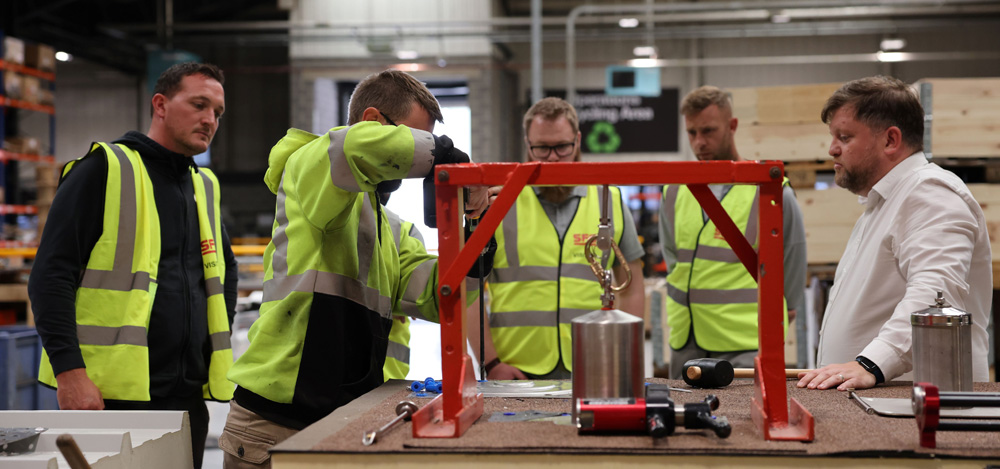Rinnai’s regular focus groups based in London have called for greater clarity from UK policymakers in terms of both appliances and chosen fuels for domestic and commercial installations of heating and hot water systems.
The Rinnai London group have questioned the lack of details to make future decarbonisation plans a reality and look to remove all obstacles of NetZero ambitions. The Rinnai focus group also discussed potential barriers towards wider UK electrification and hydrogen distribution. A unifying theme held by system designers and installer contractors is a lack of communication by the UK government towards these vital players in the industry as they are the main conduit to the end-consumer in both residential and commercial applications and sites.
Darren Woodward chaired the Rinnai London focus group and he commented,
“This meeting was a representational selection of well-placed proferssional, either working for large companies and organisations, operating constantly in this sector of the overall HVAC industry.
“The group focused on the negative influences delaying wider UK electrification, such as a lack of qualified installer personnel, material shortages and property compatibility. The topic of hydrogen revealed a national reluctance towards a manual transitioning of appliances, as well as concerns regarding safety and extra costs.
“A number of installers and system designers in the Rinnai London focus group felt that the UK government could improve direct communications towards heating engineers regarding future energy direction – and not appear to make and rescind policy decisions through favoured media channels and platforms. The group expressed concerns that more unbiased and information which concentrates on providing the best heating and hot water advice towards UK customers should be a priority for the UK government.

Rinani’s London group discussion echoed identical concerns held by heating and hot water installers across the UK. Issues regarding the plausibility of definitive NetZero targets and timelines were expressed, as was a feeling of inevitability of future UK hydrogen deployment regardless of the current failure to produce a demonstration hydrogen village pilot project.
The most cogent observation when speaking to heating and hot water installers across the UK is the frustration towards the UK government in not providing better detailed information that future proofs heating and hot water delivery systems. UK customers could benefit from enhanced communications between policy makers, and installers that results in the correct system being deployed in the appropriate property.
Rinnai understands the complexity of UK decarbonisation efforts and is working to readily assist the process for policy makers, system designers and customers alike. This is why Rinnai provide a comprehensive list of CPD’s on their website
and host regular discussions with industry professionals to provide a concise impression of the current energy industry landscape.

RINNAI’S H3 DECARBONISATION OFFERS PATHWAYS
& CUSTOMER COST REDUCTIONS FOR
COMMERCIAL, DOMESTIC AND OFF-GRID HEATING & HOT WATER DELIVERY
Rinnai’s H3 range of decarbonising products include hydrogen / BioLPG ready technology, hybrid systems, and a wide range of LOW GWP heat pumps and solar thermal. Also, within Rinnai’s H3 range is Infinity hydrogen blend ready and BioLPG ready continuous flow water heaters which are stacked with a multitude of features that ensure long life, robust & durable use, customer satisfaction and product efficiency.
Rinnai’s range of decarbonising products – H1/H2/H3 – consists of heat pump, solar, hydrogen in any configuration, hybrid formats for either residential or commercial applications. Rinnai’s H3 range of products offer contractors, consultants and end users a range of efficient, robust and affordable decarbonising appliances which create practical, economic and technically feasible solutions. The range covers all forms of fuels and appliances currently available – electric, gas, hydrogen, BioLPG, rDME solar thermal, low GWP heat pumps and electric water heaters.
Rinnai H1 continuous water heaters and boilers offer practical and economic decarbonization delivered through technological innovation in hydrogen and renewable liquid gas ready technology.
Rinnai’s H1 option is centred on hydrogen, as it is anticipated that clean hydrogen fuels will become internationally energy market-relevant in the future; Rinnai water heaters are hydrogen 20% blends ready and include the world’s first 100% hydrogen-ready hot water heating technology.
Rinnai H2 – Decarbonization simplified with renewable gas-ready units, Solar Thermal and Heat Pump Hybrids. Rinnai H2 is designed to introduce a practical and low-cost option which may suit specific sites and enable multiple decarbonisation pathways with the addition of high performance.
Rinnai H3 – Low-GWP heat pump technology made easy – Rinnai heat pumps are available for domestic and commercial usage with an extensive range of 4 – 115kW appliances.
Rinnai’s H3 heat pumps utilise R32 refrigerant and have favourable COP and SCOP.
Rinnai is a world leading manufacturer of hot water heaters and produces over two million units a year, operating on each of the five continents. The brand has gained an established reputation for producing products that offer high performance, cost efficiency and extended working lives.
Rinnai’s commercial and domestic continuous flow water heaters offer a limitless supply of instantaneous temperature controlled hot water and all units are designed to align with present and future energy sources. Rinnai condensing water heaters accept either existing fuel or hydrogen gas blends. Rinnai units are also suited for off-grid customers who require LPG and BioLPG or rDME.
Rinnai products are i2HY20 certified, A-rated water efficiency, accessed through multiple fuel options and are available for purchase 24/7, 365 days a year. Any unit can be delivered to any UK site within 24 hours. Rinnai offer carbon and cost comparison services that will calculate financial and carbon savings made when investing in a Rinnai system. Rinnai also provide a system design service that will suggest an appropriate system for the property in question. Rinnai offer comprehensive training courses and technical support in all aspects of the water heating industry including detailed CPD’s. More information can be found on Rinnai’s website and its “Help Me Choose” webpage.







